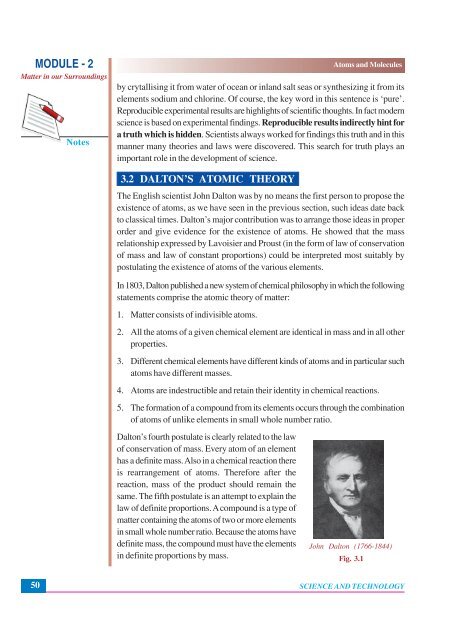You also want an ePaper? Increase the reach of your titles
YUMPU automatically turns print PDFs into web optimized ePapers that Google loves.
MODULE - 2<br />
Matter in our Surroundings<br />
Notes<br />
Atoms and Molecules<br />
by crytallising it from water of ocean or inland salt seas or synthesizing it from its<br />
elements sodium and chlorine. Of course, the key word in this sentence is ‘pure’.<br />
Reproducible experimental results are highlights of scientific thoughts. In fact modern<br />
science is based on experimental findings. Reproducible results indirectly hint for<br />
a truth which is hidden. Scientists always worked for findings this truth and in this<br />
manner many theories and laws were discovered. This search for truth plays an<br />
important role in the development of science.<br />
3.2 DALTON’S ATOMIC THEORY<br />
The English scientist John Dalton was by no means the first person to propose the<br />
existence of atoms, as we have seen in the previous section, such ideas date back<br />
to classical times. Dalton’s major contribution was to arrange those ideas in proper<br />
order and give evidence for the existence of atoms. He showed that the mass<br />
relationship expressed by Lavoisier and Proust (in the form of law of conservation<br />
of mass and law of constant proportions) could be interpreted most suitably by<br />
postulating the existence of atoms of the various elements.<br />
In 1803, Dalton published a new system of chemical philosophy in which the following<br />
statements comprise the atomic theory of matter:<br />
1. Matter consists of indivisible atoms.<br />
2. All the atoms of a given chemical element are identical in mass and in all other<br />
properties.<br />
3. Different chemical elements have different kinds of atoms and in particular such<br />
atoms have different masses.<br />
4. Atoms are indestructible and retain their identity in chemical reactions.<br />
5. The formation of a compound from its elements occurs through the combination<br />
of atoms of unlike elements in small whole number ratio.<br />
Dalton’s fourth postulate is clearly related to the law<br />
of conservation of mass. Every atom of an element<br />
has a definite mass. Also in a chemical reaction there<br />
is rearrangement of atoms. Therefore after the<br />
reaction, mass of the product should remain the<br />
same. The fifth postulate is an attempt to explain the<br />
law of definite proportions. A compound is a type of<br />
matter containing the atoms of two or more elements<br />
in small whole number ratio. Because the atoms have<br />
definite mass, the compound must have the elements<br />
in definite proportions by mass.<br />
John Dalton (1766-1844)<br />
Fig. 3.1<br />
50<br />
SCIENCE <strong>AND</strong> TECHNOLOGY
















